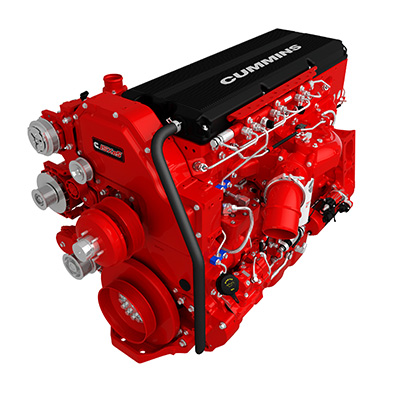How one fuel company is tackling the challenge of clean and efficient running for modern engines — and older ones
Complaints from operators about modern truck engines are nothing new — concerns around reliability or running costs are commonplace.
The drive for cleaner-running diesel engines that has been under way since before the turn of the century has spawned some of the biggest jumps in engine technology that trucking has seen for decades.
Such a radical change in the way that big bore engines burn fuel and put power to the ground has not been without some teething issues, especially in a demanding transport environment such as Australia’s.
Interestingly, much of this has taken place against the backdrop of getting more from less.
Engine downsizing continues to be a global trend and in many markets power plants of 12 to 13 litres are becoming the norm as fuel economy and emissions targets are mandated.
Only 30 years ago a 14-litre engine was good for 350-400hp (261-298kW), now horsepower ratings of more than 540hp (404.7kW) and more are common from just 13 litres.
Engineering tolerances have shrunk as engine makers strive to find the delicate balance between performance, economy, reliability and cleanliness.
The advent of ADR80/03 (Euro 5) emissions has seen a lot of stress put on truck engine fuel systems.
The arrival of early exhaust gas recirculation (EGR) engines saw some operators take a hit on fuel economy as operating temperatures increased. But high pressure common-rail fuel injection systems have resulted in massive pressures being applied to injectors.
Even selective catalytic reduction (SCR) engines use ultra-high pressure injection systems to get fuel into the combustion chamber efficiently and cleanly.
The smallest deposit on an injector can affect an engine’s performance and economy.
These days a modern engine really is trying to thread a camel through the eye of a needle, at more than 30,000psi.
Clearly fuel cleanliness and system maintenance play a big part in avoiding issues, however Caltex recently carried out an Australian trial with its new fuel product called Active TecD.
I spoke to Caltex fuels product manager Grant Perris and fuels technology manager Aimee Dretvic recently about the fuel trial and what the results showed up.
Perris says the company was responding to discussions with customers about reducing operating costs and improving fuel economy.
“We thought, what can we do?” Perris says.
“It doesn’t take much to block up an injector these days.”
“Newer engines with high pressure common-rail fuel systems are by design more sensitive to deposit formation,” Dretvic says.
The company initially consulted with Isuzu on injector wear and trialled the new fuel formula with the truck maker.
Lab trials were also conducted on a brand new Cummins QSK19.
In the lab, the company used a zinc additive in the fuel to artificially create injector deposits on the big capacity Cummins.
Active TecD fuel was then introduced and improvements in fuel economy were recorded after 96 hours according to Dretvic, “and after 144 hours, the fuel system was completely cleaned up”.
It turns out the laboratory trials also showed a clear reduction in fuel use when using Active TecD.
“When used in engines with existing deposits, the product will immediately start working to remove them,” Dretvic says.
“The injectors in engines with higher mileage will typically contain high levels of deposits, and so the degree of deposit clean up and performance improvement with Caltex Active TecD can be quite noticeable.”
But the lab is one thing and then the real world is another.
The company then ran some field trials in a transport company fleet using four Kenworth trucks of varying ages and operating in different roles.
 |
|
The Cummins ISXe5 engine featured in testing.
|
The Cummins powered trucks ranged from a Gen 1 EGR Cummins with 700,000km on the clock to two Gen 2 EGR Cummins engines with approximately 250,000km under their belts and one ISXe5 SCR engine with 322,000km on the clock.
Each truck was driven by the same three drivers during the trial which ran for more than five months.
The results make for interesting reading, especially in the case of the oft maligned Gen 1 EGR powered vehicle.
This truck had the most kilometres on the clock yet it showed the most significant improvement according to Caltex figures.
This vehicle showed a fuel economy improvement of a whopping 4.1 per cent.
One of the Gen 2 EGR powered trucks recorded an improvement of 2.9 per cent while the other Gen 2 truck registered barely any improvement (0.4 per cent).
The e5 SCR truck came in with an improvement of 1.6 per cent.
While clearly a fuel like Active TecD is going to be more expensive than regular diesel, Perris was keen to point out with potential fuel savings like this it still adds up as a business proposition.
“It also minimises the impact of temperature and optimises performance,” he says.
“Active TecD acts as a preventative in new engines yet cleans older engines as well.
“Yes, you’re paying more for the fuel but we can demonstrate real savings.”
The team were keen to point out all of the gathered data is Australian.
“Caltex is an Australian company, though we do have a partnership with Chevron,” Perris says.
Dretvic echoes this saying Caltex is in the process of beefing up its fuel expertise and demonstrating a real commitment around fuel development for the Australian trucking industry.
“As well as reducing emissions,” she says.
According to Caltex, at least, it appears putting more in your tank can actually reward you in the long run, enabling you to get more from less over the long-haul.


